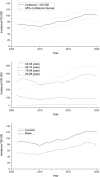Incidence and prevalence of neovascular age-related macular degeneration: 15-year epidemiological study in a population-based cohort in Finland
- PMID: 37306515
- PMCID: PMC10262804
- DOI: 10.1080/07853890.2023.2222545
Incidence and prevalence of neovascular age-related macular degeneration: 15-year epidemiological study in a population-based cohort in Finland
Abstract
Background/objectives: Neovascular age-related macular degeneration (nAMD) is a common cause for visual impairment in the ageing population. An increasing number of nAMD patients causes significant health burden, although intravitreal anti-VEGF agents have revolutionized nAMD treatment during the past 15 years. We aimed to define incidence and prevalence of nAMD in different age-categories in the anti-VEGF era and to estimate the number of the individuals over 75 years of age in 2050.
Patients and methods: We conducted an epidemiological study of the nAMD cohort (n = 2121) in a Finnish population of 410,000 inhabitants. Demographic and clinical data were gathered from Oulu University Hospital's database during 2006-2020. The incidence and prevalence rates were calculated using population data from national registers. The three-year moving average of incidence of nAMD per 100,000 person years was estimated. Prevalence figures were calculated per 100,000 age-specific inhabitants.
Results: The average age at the diagnosis of nAMD was 788 years, and 62% of the patients were women. The incidence of nAMD was 71 (95% CI 55-90) and 102 (95% CI 88-118) per 100,000 person years in 2006 and 2020, respectively. During 2006-2020, 1.2- and 2.4-fold increases in nAMD incidence were noted in 75-84 and in 85-96 age groups, respectively. In the oldest 75-84 and 85-96 age categories the nAMD prevalence was 2865/100,000 (3%, 95% CI 2665-3079) and 2620/100,000 (3%, 95% CI 2323-2956), respectively. The proportion of the inhabitants >75 years old is estimated to increase from 10% in 2020 to 17% by 2050.
Conclusions: Our results indicate constant 1.2- and 2.4-fold increases in nAMD incidence during the past 15 years in age groups of 75-84 and 85-96 years, respectively, and 3% prevalence of nAMD in 2020. An almost two-fold increase in the ageing population by the year 2050 may also predict the trends in nAMD.KEY MESSAGESThe results of the current population-based study indicate 1.2- and 2.4-fold increases in the incidence of neovascular AMD (nAMD) during the last 15 years in the Finnish population aged 75-84 and 85-96 years and 3% prevalence of nAMD in 2020.An almost two-fold increase in the number of individuals over 75 years of age by the year 2050 is estimated, which may also predict the trends in nAMD.Intravitreal anti-vascular endothelial growth factor (anti-VEGF)- agents have revolutionized the treatment and prognosis of nAMD. Timely recognition and referral of nAMD patients to ophthalmologist can ensure vision-related functionality especially among the ageing population.
Keywords: Age-related macular degeneration; ageing population; incidence; prevalence.
Conflict of interest statement
No potential conflict of interest was reported by the author(s).
Figures


References
MeSH terms
Substances
LinkOut - more resources
Full Text Sources
Miscellaneous
